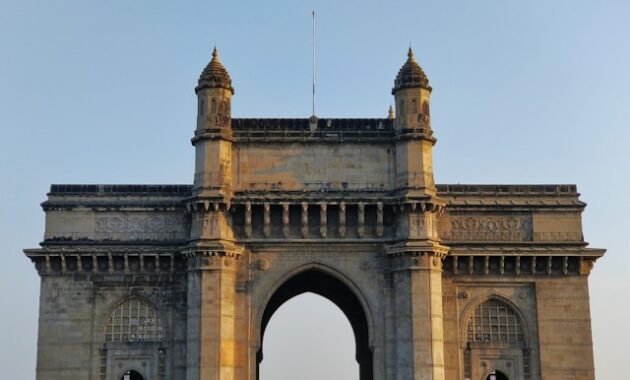
Mumbai, often referred to as the City of Dreams, is not only India’s financial capital but also a city steeped in history and culture. The metropolis boasts a fascinating past that intertwines colonial influences, ancient civilizations, and modern urbanization. For history enthusiasts, Mumbai offers a treasure trove of historical landmarks, each narrating a unique story of its glorious past. Here, we take you through the top historical landmarks in Mumbai that you must visit to experience the city’s rich heritage.
1. Gateway of India – The Iconic Landmark

One of Mumbai’s most recognizable monuments, the Gateway of India stands tall on the waterfront, overlooking the Arabian Sea. Built in 1924, this grand archway commemorates the visit of King George V and Queen Mary to India. Constructed in Indo-Saracenic and Mughal architectural styles, the Gateway has been a witness to various historic events, including the departure of British troops in 1948, marking the end of British rule in India. Today, it remains a bustling tourist attraction and a prime spot for photography.
2. Chhatrapati Shivaji Maharaj Terminus – A Victorian-Era Marvel
Formerly known as Victoria Terminus (VT), the Chhatrapati Shivaji Maharaj Terminus (CSMT) is a UNESCO World Heritage Site and an architectural masterpiece. Designed by British architect Frederick William Stevens, the terminus showcases a fusion of Victorian Gothic and Indian architectural elements. Opened in 1887 to honor Queen Victoria’s Golden Jubilee, this railway station is an operational transport hub and a visual delight with its stunning domes, stained glass windows, and intricate carvings.
3. Elephanta Caves – Ancient Rock-Cut Temples
Located on Elephanta Island, these rock-cut caves date back to the 5th and 6th centuries. A UNESCO World Heritage Site, the Elephanta Caves are dedicated to Lord Shiva and feature intricate carvings and sculptures depicting Hindu mythology. The most famous sculpture here is the colossal Trimurti, a three-faced representation of Shiva. A ferry ride from the Gateway of India takes visitors to this historical wonder, offering a glimpse into India’s ancient artistry and religious heritage.
4. Mani Bhavan – Gandhi’s Mumbai Abode
A must-visit for history buffs, Mani Bhavan was Mahatma Gandhi’s residence in Mumbai from 1917 to 1934. This two-story building played a crucial role in India’s freedom movement, serving as the headquarters for Gandhi’s political activities. Today, it functions as a museum, housing a library, photographs, and letters that provide deep insights into Gandhi’s life and philosophies. The charkha (spinning wheel) used by Gandhi is one of the key exhibits here.
5. Haji Ali Dargah – A Spiritual Marvel
One of Mumbai’s most revered religious landmarks, the Haji Ali Dargah is a mosque and tomb located on a small islet off the coast of Worli. Built in 1431 in memory of Sayyed Pir Haji Ali Shah Bukhari, a wealthy merchant-turned-saint, the dargah is a stunning example of Indo-Islamic architecture. Accessible only via a narrow causeway, the shrine appears to float on the sea, creating a mesmerizing visual effect. Devotees and tourists visit to seek blessings and admire the breathtaking ocean views.
6. Chhatrapati Shivaji Maharaj Vastu Sangrahalaya – The City’s Premier Museum
Formerly known as the Prince of Wales Museum, this museum is one of India’s finest heritage institutions. Built in the early 20th century, the museum’s Indo-Saracenic architecture is a spectacle in itself. Inside, visitors can explore a vast collection of artifacts, including sculptures, miniature paintings, weaponry, and textiles from different historical periods. The museum provides an insightful journey through India’s past, making it an essential visit for culture lovers.
7. Bombay High Court – A Colonial Legacy
One of the oldest High Courts in India, the Bombay High Court, is an architectural gem built in neo-Gothic styleduring British rule. Established in 1862, the court has been a pivotal center for legal proceedings in India’s history. The structure’s pointed arches, intricate carvings, and historic significance make it a landmark worth exploring, even if just for its exterior grandeur.
8. Rajabai Clock Tower – Mumbai’s Big Ben
Standing tall within the University of Mumbai campus, the Rajabai Clock Tower is an imposing Gothic structuremodeled after London’s Big Ben. Completed in 1878, the tower features stunning stained-glass windows and intricate detailing. Funded by the wealthy stockbroker Premchand Roychand in memory of his mother Rajabai, the tower offers an excellent example of Mumbai’s colonial-era architecture.
9. Mount Mary Church – A Beacon of Faith
Located in Bandra, Mount Mary Basilica is a 300-year-old Roman Catholic Church that attracts thousands of pilgrims every year. Perched atop a hill, the church offers breathtaking views of the Arabian Sea. The annual Bandra Fair, held in September, is a vibrant event where devotees come to seek blessings and enjoy local festivities. The peaceful ambiance and stunning architectural details make it a serene historical site.
10. Flora Fountain – A Symbol of Colonial Mumbai
One of Mumbai’s most picturesque landmarks, Flora Fountain, stands in the heart of the city at Hutatma Chowk. Built in 1864, this intricately sculpted fountain is dedicated to the Roman goddess Flora. The fountain symbolizes Mumbai’s colonial past and is surrounded by numerous historic buildings, making it a popular spot for history enthusiasts and photographers.
Conclusion
Mumbai’s historical landmarks paint a vivid picture of its past, blending colonial grandeur, religious sanctity, and ancient artistry. Whether you are a history lover, architecture enthusiast, or a curious traveler, these sites offer a fascinating journey through time. Each monument holds stories of resilience, transformation, and cultural richness, making Mumbai a city that truly celebrates its heritage.